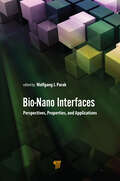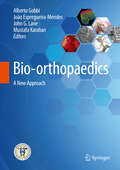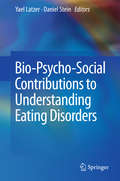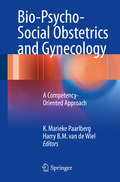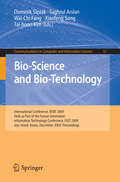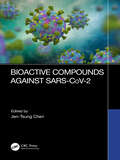- Table View
- List View
Bio-Nano Interfaces: Perspectives, Properties, and Applications
by Wolfgang J. ParakIn recent decades, bio-nano interfaces have become a popular topic of research. The interface between biology (e.g., cells, proteins) and man-made materials (e.g., surfaces of labware, medical devices/implants, etc., that are exposed to the biological matter) has always been important, way before the terms of nanotechnology and nanoscience were coined. Nanotechnology brought new techniques into play, with which such interfaces can be investigated with an additional viewpoint. This book is a collection of articles spanning two decades that shows how the newer publications have evolved from the older ones. This allows the reader to see the development in the field not only technically but also conceptually. The book is, in particular, suitable for the researchers and general readers who are looking for inspiration on how ideas develop over decades.
Bio-Nanomedicine for Cancer Therapy (Advances in Experimental Medicine and Biology #1295)
by Flavia Fontana Hélder A. SantosThe book covers the latest developments in biologically-inspired and derived nanomedicine for cancer therapy. The purpose of the book is to illustrate the significance of naturally-mimicking systems for enhancing the dose delivered to the tumor, to improve stability, and prolong the circulation time. Moreover, readers are presented with advanced materials such as adjuvants for immunostimulation in cancer vaccines. The book also provides a comprehensive overview of the current status of academic research. This is an ideal book for students, researchers, and professors working in nanotechnology, cancer, targeted drug delivery, controlled drug release, materials science, and biomaterials as well as companies developing cancer immunotherapy.
Bio-Objects: Life in the 21st Century (Theory, Technology and Society)
by Niki Vermeulen Sakari Tamminen Andrew WebsterIncreasing knowledge of the biological is fundamentally transforming what life itself means and where its boundaries lie. New developments in the biosciences - especially through the molecularisation of life - are (re)shaping healthcare and other aspects of our society. This cutting edge volume studies contemporary bio-objects, or the categories, materialities and processes that are central to the configuring of 'life' today, as they emerge, stabilize and circulate through society. Examining a variety of bio-objects in contexts beyond the laboratory, Bio-Objects: Life in the 21st Century explores new ways of thinking about how novel bio-objects enter contemporary life, analysing the manner in which, among others, the boundaries between human and animal, organic and non-organic, and being 'alive' and the suspension of living, are questioned, destabilised and in some cases re-established. Thematically organised around questions of changing boundaries; the governance and regulation of bio-objects; and changing social, economic and political relations, this book presents rich new case studies from Europe that will be of interest to scholars of science and technology studies, social theory, sociology and law.
Bio-Objects: Life in the 21st Century (Theory, Technology and Society)
by Niki Vermeulen Sakari Tamminen Andrew WebsterIncreasing knowledge of the biological is fundamentally transforming what life itself means and where its boundaries lie. New developments in the biosciences - especially through the molecularisation of life - are (re)shaping healthcare and other aspects of our society. This cutting edge volume studies contemporary bio-objects, or the categories, materialities and processes that are central to the configuring of 'life' today, as they emerge, stabilize and circulate through society. Examining a variety of bio-objects in contexts beyond the laboratory, Bio-Objects: Life in the 21st Century explores new ways of thinking about how novel bio-objects enter contemporary life, analysing the manner in which, among others, the boundaries between human and animal, organic and non-organic, and being 'alive' and the suspension of living, are questioned, destabilised and in some cases re-established. Thematically organised around questions of changing boundaries; the governance and regulation of bio-objects; and changing social, economic and political relations, this book presents rich new case studies from Europe that will be of interest to scholars of science and technology studies, social theory, sociology and law.
Bio-orthopaedics: A New Approach
by Alberto Gobbi João Espregueira-Mendes John G. Lane Mustafa KarahanThis book introduces the exciting field of orthobiology, which will usher in a new array of therapeutic approaches that stimulate the body’s natural resources to regenerate musculoskeletal tissues damaged by trauma or disease. The book addresses a range of key topics and discusses emerging approaches that promise to offer effective alternatives to traditional treatments for injuries to bone, cartilage, muscles, ligaments, and tendons. It explains in detail how a variety of innovative products, including biomaterials, growth factors, and autogenous cells, together provide the basis for the regeneration of these musculoskeletal structures and how recent scientific progress has created unique opportunities to address pathological situations that until recently have been treated with unsatisfactory results. The authors are experts from across the world who come together to provide a truly global overview. The book is published in collaboration with ISAKOS. It will be invaluable for all with an interest in this area of medicine, which has already attained huge popularity in Orthopaedics and Sports Medicine and has also attracted the attention of the lay public.
Bio-Psycho-Social Contributions to Understanding Eating Disorders
by Yael Latzer Daniel SteinThis book uniquely combines cutting-edge medical, psychological, and sociocultural topics pertinent to eating disorders. In the medical realm, the book focuses on Eating Disorders’ newly investigated associations with ADHD and sleep disorders, and on innovative treatments of osteoporosis in anorexia nervosa. Novel contributions in the psychological realm address families’ trans-generational transmission of Eating Disorders-related difficulties and novel internet-based treatments for such families. Lastly, in the sociocultural realm, the book discusses social contagion and Pro-Ana websites as increasing risk for disordered eating in young women around the globe. This volume provides readers with more holistic perspectives of each realm and their interplay, to promote Eating Disorders’ understanding, treatment, prevention, and research. It provides various professionals including mental health providers, physicians, nutritionists, and graduate students in these professions.
Bio-Psycho-Social Obstetrics and Gynecology: A Competency-Oriented Approach
by K Marieke Paarlberg Harry B.M. van de WielThis book will assist the reader by providing individually tailored, high-quality bio-psycho-social care to patients with a wide range of problems within the fields of obstetrics, gynaecology, fertility, oncology, and sexology. Each chapter addresses a particular theme, issue, or situation in a problem-oriented and case-based manner that emphasizes the differences between routine and bio-psycho-social care. Relevant facts and figures are presented, advice is provided regarding the medical, psychological, and caring process, and contextual aspects are discussed. The book offers practical tips and actions within the bio-psycho-social approach, and highlights important do’s and don’ts. To avoid a strict somatic thinking pattern, the importance of communication, multidisciplinary collaboration, and creation of a working alliance with the patient is emphasized. The book follows a consistent format, designed to meet the needs of challenged clinicians.
Bio-Science and Bio-Technology: International Conference, BSBT 2009 Held as Part of the Future Generation Information Technology Conference, FGIT 2009 Jeju Island, Korea, December 10-12, 2009 Proceedings (Communications in Computer and Information Science #57)
by Dominik 346 L 281 Zak Tughrul Arslan Xiaofeng Song Tai-Hoon KimAs future generation information technology (FGIT) becomes specialized and fr- mented, it is easy to lose sight that many topics in FGIT have common threads and, because of this, advances in one discipline may be transmitted to others. Presentation of recent results obtained in different disciplines encourages this interchange for the advancement of FGIT as a whole. Of particular interest are hybrid solutions that c- bine ideas taken from multiple disciplines in order to achieve something more signi- cant than the sum of the individual parts. Through such hybrid philosophy, a new principle can be discovered, which has the propensity to propagate throughout mul- faceted disciplines. FGIT 2009 was the first mega-conference that attempted to follow the above idea of hybridization in FGIT in a form of multiple events related to particular disciplines of IT, conducted by separate scientific committees, but coordinated in order to expose the most important contributions. It included the following international conferences: Advanced Software Engineering and Its Applications (ASEA), Bio-Science and Bio-Technology (BSBT), Control and Automation (CA), Database Theory and Application (DTA), D- aster Recovery and Business Continuity (DRBC; published independently), Future G- eration Communication and Networking (FGCN) that was combined with Advanced Communication and Networking (ACN), Grid and Distributed Computing (GDC), M- timedia, Computer Graphics and Broadcasting (MulGraB), Security Technology (SecTech), Signal Processing, Image Processing and Pattern Recognition (SIP), and- and e-Service, Science and Technology (UNESST).
Bio-Targets and Drug Delivery Approaches
by Sabyasachi Maiti Kalyan Kumar SenThe advances in drug delivery systems over recent years have resulted in a large number of novel delivery systems with the potential to revolutionize the treatment and prevention of diseases. Bio-Targets and Drug Delivery Approaches is an easy-to-read book for students, researchers and pharmaceutical scientists providing a comprehensive introduction to the principles of advanced drug delivery and targeting their current applications and potential future developments.
Bio-Targets and Drug Delivery Approaches
by Sabyasachi Maiti and Kalyan Kumar SenThe advances in drug delivery systems over recent years have resulted in a large number of novel delivery systems with the potential to revolutionize the treatment and prevention of diseases. Bio-Targets and Drug Delivery Approaches is an easy-to-read book for students, researchers and pharmaceutical scientists providing a comprehensive introduction to the principles of advanced drug delivery and targeting their current applications and potential future developments.
Bioactive Ceramides in Health and Disease: Intertwined Roles of Enigmatic Lipids (Advances in Experimental Medicine and Biology #1159)
by Johnny StibanThis book is about the various roles of bioactive ceramides and other sphingolipids in cellular biology. The enigmatic biophysical and biochemical properties of ceramides and their propensity to influence membranes whether as rafts or protein-permeable channels are heavily discussed. Metabolism of ceramides and their metabolites is also focused with ceramide synthase family of proteins being a target of extensive review. Ceramide 1-phosphate and other sphingolipids are also presented in cellular physiology and pathophysiology. Prokaryotic origins of mitochondria at the level of membranes and the occurrence of apoptosis in bacteria are presented. Many aspects of ceramide and sphingolipid biology are addressed in this book. Its focus is the metabolism of ceramide in normal and diseased states and the biophysical and biochemical mechanisms governing the bioactivity of these molecules. Sphingolipid research has surged over the past thirty years and this book gathers the recent findings of various aspects of sphingolipid biochemistry. World-renowned scientists from the field of lipid biology, specifically sphingolipid biochemistry, were gathered to write this book. Scholars from most continents of the globe committed to write diligently about their expertise and the newest findings in the relevant fields. This book came to fruition after almost a year and a half of laborious preparation and diligent writings. This book is targeted to the experienced reader who is looking to read about the various aspects of bioactive ceramide signaling, as well as to the newcomer into the field, as the topics are explained in concise yet very informative manner. The authors and editor wish all readers a pleasant time reading this volume, and are adamant that this book will meet all expectations.
Bioactive Components, Diet and Medical Treatment in Cancer Prevention
by Mostafa I. Waly Mohammad Shafiur RahmanThe high rate of urbanization and a steady increase in per capita income has improved the socio-economic status of people all over the world. This has resulted in drastic changes in their lifestyle and food consumption patterns, where traditional foods are being replaced with more ready-made junk foods with few servings of fresh vegetables and fruits. It has been postulated that industrialization has caused change in food choice, dietary pattern modification and resulted in a sedentary lifestyle. In addition, contaminated foods with unsafe microbes and chemical hazards are increasing. All of these events have resulted in an increased risk of cancer, the leading cause of mortality and morbidity worldwide.This book will provide a basic understanding of cancer, its risk factors, preventive measures, and possible treatments currently available, as well as identifying the different dietary factors that might synergize with a sedentary lifestyle in the etiology of cancer, and its prevention measure.
Bioactive Components of Human Milk: (pdf) (Advances in Experimental Medicine and Biology #501)
by David S. NewburgBioactive Compounds Against SARS-CoV-2
by Jen-Tsung ChenCoronaviruses can cause illness, severe disease, and death; for example, Middle East respiratory syndrome (MERS), severe acute respiratory syndrome (SARS), and COVID-19. Vaccine development and antiviral drugs are challenged by the propensity for viral mutations allowing these viruses to evade such therapies. There are a number of bioactive compounds from natural sources, which can exert health benefits and act as antiviral therapies such as anti-inflammation, antioxidative stress, and immune regulation. This book summarizes research on the potential efficacy and underlying mechanisms of bioactive compounds and traditional medicines against SARS-CoV-2. Key Features Summarizes the potential benefits of bioactive therapies for coronaviruses Focuses on COVID-19, but also covers MERS and SARS Provides alternatives to vaccines and other antiviral drugs whose efficacy is reduced by viral mutations Relevant for clinicians and public health officials
Bioactive Compounds Against SARS-CoV-2
by Jen-Tsung ChenCoronaviruses can cause illness, severe disease, and death; for example, Middle East respiratory syndrome (MERS), severe acute respiratory syndrome (SARS), and COVID-19. Vaccine development and antiviral drugs are challenged by the propensity for viral mutations allowing these viruses to evade such therapies. There are a number of bioactive compounds from natural sources, which can exert health benefits and act as antiviral therapies such as anti-inflammation, antioxidative stress, and immune regulation. This book summarizes research on the potential efficacy and underlying mechanisms of bioactive compounds and traditional medicines against SARS-CoV-2. Key Features Summarizes the potential benefits of bioactive therapies for coronaviruses Focuses on COVID-19, but also covers MERS and SARS Provides alternatives to vaccines and other antiviral drugs whose efficacy is reduced by viral mutations Relevant for clinicians and public health officials
Bioactive Compounds and Cancer (Nutrition and Health)
by John A. Milner Donato F. RomagnoloBecause of the wealth of new information generated by the scientific community during the last decade on the role of nutrition on cancer risk, this book provides a forum for presentation and discussion of recent scientific data and highlights a set of dietary recommendations. Bioactive Compounds and Cancer presents chapters that highlight laboratory and clinical findings on how selected nutrients function as signaling molecules and, as such, influence cellular behavior and cancer predisposition. This important compendium focuses on understanding the role of nutrition in cancer biology, the molecular action of bioactive food components and xenobiotics on cancer risk, the role of dietary components in cancer prevention and/or treatment, and nutrition education with the most up to date dietary recommendations that may reduce cancer risk. This volume will be of interest to specialized health professionals, clinicians, nurses, basic and clinical researchers, graduate students, and health officials of public and private organizations.
Bioactive Compounds and Nutraceuticals from Dairy, Marine, and Nonconventional Sources: Extraction Technology, Analytical Techniques, and Potential Health Prospects
by Parmjit S. Panesar Charanjit S. RiarThis new volume begins with an overview of bioactive compounds and nutraceuticals along with explanations of their chemical characteristics, profile, and physicochemical aspects. The volume discusses the extraction technologies of active ingredients and the analytical techniques of qualitative and qualitative analysis along with the profiling of functional compounds and nutraceuticals. The volume gives detailed descriptions of the techniques for extraction, isolation, and characterization of active ingredients from food preparations.The volume also discusses important bioactive compounds and nutraceuticals specifically from milk and dairy products as well as from marine algae and seaweeds. From there, the volume explores bioactive compounds and nutraceuticals from nonconventional sources, such as from spices and condiments, and from microbial sources.This volume is the companion volume to the book Bioactive Compounds and Nutraceuticals from Plant Sources: Extraction Technology, Analytical Techniques, and Potential Health Prospects by the same editors.
Bioactive Compounds and Nutraceuticals from Dairy, Marine, and Nonconventional Sources: Extraction Technology, Analytical Techniques, and Potential Health Prospects
This new volume begins with an overview of bioactive compounds and nutraceuticals along with explanations of their chemical characteristics, profile, and physicochemical aspects. The volume discusses the extraction technologies of active ingredients and the analytical techniques of qualitative and qualitative analysis along with the profiling of functional compounds and nutraceuticals. The volume gives detailed descriptions of the techniques for extraction, isolation, and characterization of active ingredients from food preparations.The volume also discusses important bioactive compounds and nutraceuticals specifically from milk and dairy products as well as from marine algae and seaweeds. From there, the volume explores bioactive compounds and nutraceuticals from nonconventional sources, such as from spices and condiments, and from microbial sources.This volume is the companion volume to the book Bioactive Compounds and Nutraceuticals from Plant Sources: Extraction Technology, Analytical Techniques, and Potential Health Prospects by the same editors.
Bioactive Compounds and Nutraceuticals from Plant Sources: Extraction Technology, Analytical Techniques, and Potential Health Prospects
by Parmjit S. Panesar Charanjit S. RiarThis new volume focuses on the technology of bioactive compounds and nutraceuticals from fruit and vegetable sources, from cereal grain sources, and from cereal processing by-products. The chapters look at the extraction technologies, analytical techniques, and potential health prospects specifically from fruits and vegetables sources. They cover plants such plantation crops, roots, and tubers, as well as fruit and vegetable processing byproducts. They also consider bioactive compounds and nutraceuticals from major and minor cereal grain sources and from cereal processing byproducts.This new book provides valuable insight for food technologists and those in related areas of research. Bioactive Compounds and Nutraceuticals from Plant Sources: Extraction Technology, Analytical Techniques, and Potential Health Prospects is the companion volume to Bioactive Compounds and Nutraceuticals from Dairy, Marine, and Nonconventional Sources: Extraction Technology, Analytical Techniques, and Potential Health Prospects by the same editors.
Bioactive Compounds and Nutraceuticals from Plant Sources: Extraction Technology, Analytical Techniques, and Potential Health Prospects
This new volume focuses on the technology of bioactive compounds and nutraceuticals from fruit and vegetable sources, from cereal grain sources, and from cereal processing by-products. The chapters look at the extraction technologies, analytical techniques, and potential health prospects specifically from fruits and vegetables sources. They cover plants such plantation crops, roots, and tubers, as well as fruit and vegetable processing byproducts. They also consider bioactive compounds and nutraceuticals from major and minor cereal grain sources and from cereal processing byproducts.This new book provides valuable insight for food technologists and those in related areas of research. Bioactive Compounds and Nutraceuticals from Plant Sources: Extraction Technology, Analytical Techniques, and Potential Health Prospects is the companion volume to Bioactive Compounds and Nutraceuticals from Dairy, Marine, and Nonconventional Sources: Extraction Technology, Analytical Techniques, and Potential Health Prospects by the same editors.
Bioactive Compounds from Multifarious Natural Foods for Human Health: Foods and Medicinal Plants (Innovations in Plant Science for Better Health)
by Megh R. Goyal Hafiz Ansar Rasul Suleria Huma Bader Ul AinDivided into two sections, the volume first examines health claims of food-based bioactive compounds, which are extra-nutritional constituents that typically occur in small quantities in foods. This section lays out the concepts of extraction of food-based bioactive molecules, along with both conventional and modernized extraction techniques. The book goes to present new research on health claims of bioactive compounds from medicinal plants, their importance, and health perspectives. Both sections cover the various pharmacological and therapeutic aspects of bioactive compounds, along with their methods of extraction, their phytochemistry, their pharmacological and biological activities, their medicinal properties, and their applications for disease management and prevention. This volume sheds new light on the potential of natural and plant-based foods for human health from different technological aspects, contributing to the ocean of knowledge on food science and technology.
Bioactive Compounds from Multifarious Natural Foods for Human Health: Foods and Medicinal Plants (Innovations in Plant Science for Better Health)
by Hafiz Ansar Rasul SuleriaDivided into two sections, the volume first examines health claims of food-based bioactive compounds, which are extra-nutritional constituents that typically occur in small quantities in foods. This section lays out the concepts of extraction of food-based bioactive molecules, along with both conventional and modernized extraction techniques. The book goes to present new research on health claims of bioactive compounds from medicinal plants, their importance, and health perspectives. Both sections cover the various pharmacological and therapeutic aspects of bioactive compounds, along with their methods of extraction, their phytochemistry, their pharmacological and biological activities, their medicinal properties, and their applications for disease management and prevention. This volume sheds new light on the potential of natural and plant-based foods for human health from different technological aspects, contributing to the ocean of knowledge on food science and technology.
Bioactive Compounds from Terrestrial Extremophiles (SpringerBriefs in Microbiology)
by Lesley-Ann Giddings David J. NewmanA discussion of the chemical compounds produced by organisms living under extreme conditions that may have potential as drugs or leads to novel drugs for human use. This SpringerBrief deals with bioactive materials from terrestrial extremophiles.
Bioactive Compounds of Medicinal Plants: Properties and Potential for Human Health (Innovations in Agricultural & Biological Engineering)
by Megh R. Goyal Ademola O. AyelesoThis volume sheds new light on the immense potential of medicinal plants for human health from different technological aspects. It presents new research on bioactive compounds in medicinal plants that provide health benefits, including those that have proven especially effective in treating and managing diabetes mellitus and hypertension. It looks at the medicinal properties, antioxidant capacity, and antimicrobial activity of plants and provides scientific evidence on the use of medicinal plants in the treatment of certain diseases. Many of the plants described in the chapters are easily accessible and are believed to be effective with fewer side effects in comparison to modern drugs in the treatment of different diseases.
Bioactive Compounds of Medicinal Plants: Properties and Potential for Human Health (Innovations in Agricultural & Biological Engineering)
by Megh R. Goyal and Ademola O. AyelesoThis volume sheds new light on the immense potential of medicinal plants for human health from different technological aspects. It presents new research on bioactive compounds in medicinal plants that provide health benefits, including those that have proven especially effective in treating and managing diabetes mellitus and hypertension. It looks at the medicinal properties, antioxidant capacity, and antimicrobial activity of plants and provides scientific evidence on the use of medicinal plants in the treatment of certain diseases. Many of the plants described in the chapters are easily accessible and are believed to be effective with fewer side effects in comparison to modern drugs in the treatment of different diseases.
